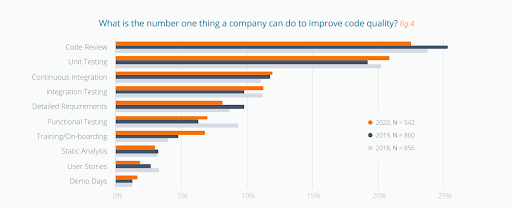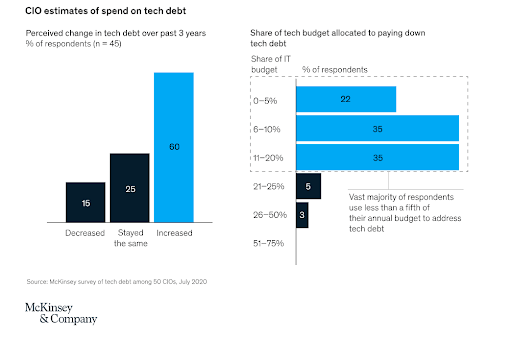A Beginner's Guide to Technical Debt

A Beginner's Guide to Technical Debt
Technical debt is inefficient and can increase costs, but how can you eliminate it? This article covers the types of technical debt, what contributes to it, and provides various strategies to help you reduce technical debt.
Technical debt is a metaphorical concept in software development that refers to the accumulated cost and consequences of design and implementation choices made in the past. While its usage varies, developers generally interpret it as insufficient time and resources spent on bug fixes, code restructuring, and system overhauls.
Coined by American computer programmer Ward Cunningham (also the inventor of the first internet wiki) around 30 years ago, it remains a key concept in software development.
If your team is allocating more time to maintenance and navigating intricate integrations, diverting attention from key priorities that drive business value, it can indicate rising technical debt within your company. Software development companies and tech leaders must understand the origins of technical debt, actively mitigate it, and harness technology for sustainable growth and innovation.
This blog highlights the real meaning of technical debt and outlines the need to effectively manage and address it to maintain a healthy and sustainable software development process.
What is Technical Debt?
Technical debt refers to the cumulative consequences of choosing quick and expedient solutions over more robust but time-consuming ones during the development process.
While functional in the short term, some solutions may not be optimal in the long run. Over time, as the software evolves and additional features are added, these suboptimal decisions can compound, leading to technical debt.
Just as financial debt accrues interest over time, technical debt compounds as these shortcuts make the codebase more complex, less maintainable, and prone to issues.
McKinsey reports that CIOs estimate that about 10-20% of the technology budget earmarked for new products is redirected to address issues linked to technical debt.
Picture technical debt as the clutter in your IT closet—inefficiencies and waste piling up when your tech resources no longer meet your organization's evolving needs. The simplest explanation would be picturing technical debt as neglecting your car's maintenance.
It slows you down, costs more in the long run, and works against your efforts to go green. It isn’t just a drain on productivity; it's a silent saboteur that inflates costs and undermines sustainability efforts. Keep your tech in top shape to avoid these roadblocks.
Types of Technical Debt
There are several types of technical debt, and people classify them in various styles. In general, it can manifest in various forms, including:
- Code Debt: It results from poorly written or inefficient code that may need refactoring.
- Design Debt: It encompasses all the imperfections in your product's UX and design processes that accumulate due to ongoing development, innovation, and the absence of design refactoring.
- Testing Debt: This occurs when testing processes are rushed or insufficient, leading to potential issues down the line.
- Documentation Debt: Arising when documentation is lacking or outdated, making it challenging for developers to understand and maintain the code.
- Dependency Debt: Stemming from reliance on outdated or insecure third-party libraries or components.
- Build and Deployment Debt: Resulting from inefficient or outdated build and deployment processes, hindering a smooth release cycle.
- Process Debt: Arising when established development processes are not followed, leading to inefficiencies and complications.
Technical Debt Quadrant
Now, the most commonly adopted way to categorize technical debt is the Technical Debt Quadrant formulated by Martin Fowler, a well-known software development expert. He reserved the use of ‘technical debt’ in specific cases, not for all the messy codes. He advocated the use of the term when a deliberate choice is made for a design strategy with short-term gains but isn't sustainable.
Fowler's classification helps teams and organizations better understand the nature of their technical debt and make informed decisions about when and how to address it.
Reckless & Deliberate
This type of debt results from hasty decision-making due to a lack of understanding of the consequences of cutting corners and neglecting best practices. However, it is a conscious or deliberate decision to prioritize speedy delivery over optimal solutions.
Example: Choosing a shortcut to meet tight deadlines despite knowing it could lead to future issues, a team deliberately incurs technical debt, prioritizing short-term gains over long-term stability.
Reckless & Inadvertent
It highlights situations where developers lack crucial knowledge. It arises when a team attempts to produce top-notch code without the required knowledge, often unaware of the mistakes being made. While individual developers may not know everything in their domain, a well-informed team with a strong grasp of coding standards can prevent this type of debt.
Example: When a team of developers delivers code without understanding the domain intricacies, they unintentionally accumulate technical debt, unaware of critical mistakes hindering long-term efficiency.
Prudent and Deliberate
This type of tech debt involves thoughtful decision-making, where engineers and product managers weigh risks and rewards, considering and planning for potential consequences in advance. They will opt to release swiftly and address consequences later with a proper plan.
Example: Opting to ship quickly and address the consequences later, recognizing that the advantages of speedy delivery outweigh the associated risks. When a startup releases its MVP, quickly prioritize the core functionalities with a plan to refine its product after funding.
Prudent and Inadvertent
Prudent and inadvertent debt (the hardest quadrant) occurs when the aim is to create optimal code, but a superior solution is discovered post-implementation. This debt often arises when it is an inevitable part of the learning process, where lessons are gained through hands-on experience. Alternatively, it may arise from using outdated approaches in an industry that evolves swiftly.
Example: When a team of developers initially chooses a design or library that seems optimal, only to find it becoming outdated or suboptimal later on as new features, functionalities, or standards emerge.
Warning Signs of Technical Debt
Some warning signs of the presence of technical debt are as follows:
- Frequent Workarounds: If developers often resort to quick fixes or workarounds instead of addressing the root cause of a problem, it can lead to the accumulation of technical debt.
- Rapid Development with Minimal Testing: Speedy development cycles with minimal testing may result in undetected bugs and issues, contributing to technical debt over time.
- High Bug Rates: A consistently high number of bugs or recurring issues may indicate underlying problems in the code that need to be addressed to prevent further technical debt.
- Difficulty in Adding New Features: If adding new features without disrupting existing functionality becomes increasingly challenging, it may be a sign of design or architectural issues contributing to technical debt.
- Long Debugging and Maintenance Cycles: If debugging and maintaining the code take longer than expected, it may indicate underlying issues in the codebase that need attention.
- Hesitancy Towards Change: When the reluctance of employees to embrace new software or hardware begins to impact decision-making, it is indicative of the existence of technical debt.
- Unhappy New Hires: Frequent changes in team members leading to knowledge gaps due to insufficient documentation or unintelligent code base. New hires may experience dissatisfaction due to persistent technical issues that the team is unwilling to address.
The consequences of technical debt include increased maintenance costs, slower development speed, decreased software quality, heightened risk of bugs, and system failures. Therefore, software developers and tech leaders must spot the common signs and symptoms indicating the presence of technical debt.
How To Manage Technical Debt
There isn't a universal formula for addressing technical debt. Each company approaches it based on its unique strategy and organizational culture. However, there are common standards that everyone can adopt to mitigate technical debt before it escalates into a crisis proactively. These also provide the best practices for clean code enhancing software performance.
- Increase visibility and improve transparency
- Embrace agile software development practices
- Review and refactor code
Increase Visibility & Improve Transparency
Enhancing visibility and promoting transparency is a crucial step in addressing technical debt. By increasing transparency, teams can better understand the existing codebase, identify potential areas of concern, and communicate effectively about necessary improvements. This approach facilitates collaboration among team members, streamlining efforts to mitigate technical debt before it impedes the development process.
It is crucial for business teams to share business context with engineering teams actively. Information sharing ensures a common understanding and helps align objectives, promoting a collaborative and cohesive working environment. A well-informed tech team, aware of the issues and their implications, is better equipped to make decisions regarding resolving technical debt.
Simultaneously, ensure thorough documentation of technical debt, including an explanation of its origins and guidelines for future resolutions. This practice provides both teams and management with transparent insights into the overall technical "credit." Armed with this knowledge, teams can make informed decisions during future planning, estimating the implementation time for features more accurately.
Embrace Agile Software Development Practices
An Agile environment, characterized by frequent iterations of work and the regular delivery of features and bug fixes, provides an alternative approach to managing technical debt. Breaking down work into small, manageable chunks enables teams to address technical debt continuously throughout development. This incremental and iterative approach helps mitigate the accumulation of technical debt, promoting a more sustainable and adaptable software development process.

Agile teams adopt a proactive approach to managing technical debt. They engage in constant code refactoring to ensure cleanliness. They also regularly integrate new code to maintain an up-to-date design. This ongoing commitment to refining code quality allows agile teams to mitigate the accumulation of technical debt, fostering a more sustainable and adaptable development process.
Review & Refactor Code
Software development companies should establish code standards and implement routine reviews and audits of existing code. Establish a systematic process for routine audits and review of existing code. This should involve collaborative reviews and discussions within the team to explore improved solutions.
Regular code refactoring is a crucial practice for maintaining a healthy and sustainable codebase. Refactoring involves making small, incremental improvements to the existing code without changing its external behavior. Managing legacy code poses challenges when incorporating new features or modifications without introducing defects. Refactoring the code enhances manageability and facilitates a more seamless development process.
As per the 2020 State of Code Review conducted by SmartBear, a majority of the respondents said that the most effective way to enhance code quality within a company is through Code Review.

Moreover, promote a culture that avoids shaming or blaming, acknowledging that it's perfectly normal for team members not to have all the answers at any given moment. With time, the team will likely accumulate more knowledge, enhancing the developers' capabilities to implement better solutions.
Understanding and Managing Technical Debt: Key Takeaways
It's crucial for development teams to periodically address and pay down technical debt through refactoring, code improvements, and other remediation efforts to ensure the long-term health and sustainability of the software. Ignoring technical debt can lead to a point where maintenance costs become disproportionately high, hindering the ability to implement new features or respond to changing requirements effectively.
Sustainable software development is the practice of creating and maintaining software to ensure its long-term viability, adaptability, and maintainability. One significant impediment to achieving sustainability is technical debt. Addressing technical debt is crucial for providing your organization with a sustainable boost. It's essential to identify and eliminate technical debt at its roots to enhance the overall health and resilience of your software, enabling your organization to thrive in the long run.

